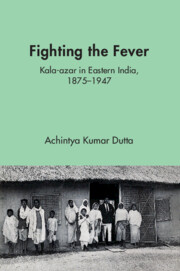Book contents
- Frontmatter
- Dedication
- Contents
- List of Figures
- List of Maps
- List of Tables
- Preface and Acknowledgements
- Note on Permissions
- List of Abbreviations
- Introduction
- 1 Kala-azar: A Disease Sui Generis
- 2 Medical Intervention and Containment of Epidemics
- 3 Agony of Assam: Defeating the Dreadful Kala-azar
- 4 Bengal’s Black Fever Burden: Beating the Disease
- 5 ‘Black Sigh’ in Bihar: Experiences and Responses
- 6 From Tartar Emetic to Urea Stibamine: Medical Research on Kala-azar and Its Fruition
- 7 The Unsung Hero: The Genius of Upendra Nath Brahmachari
- Conclusion
- Appendix: Number of Kala-azar Patients Admitted for Treatment in Bengal
- Bibliography
- Index
5 - ‘Black Sigh’ in Bihar: Experiences and Responses
Published online by Cambridge University Press: 13 February 2025
- Frontmatter
- Dedication
- Contents
- List of Figures
- List of Maps
- List of Tables
- Preface and Acknowledgements
- Note on Permissions
- List of Abbreviations
- Introduction
- 1 Kala-azar: A Disease Sui Generis
- 2 Medical Intervention and Containment of Epidemics
- 3 Agony of Assam: Defeating the Dreadful Kala-azar
- 4 Bengal’s Black Fever Burden: Beating the Disease
- 5 ‘Black Sigh’ in Bihar: Experiences and Responses
- 6 From Tartar Emetic to Urea Stibamine: Medical Research on Kala-azar and Its Fruition
- 7 The Unsung Hero: The Genius of Upendra Nath Brahmachari
- Conclusion
- Appendix: Number of Kala-azar Patients Admitted for Treatment in Bengal
- Bibliography
- Index
Summary
The chief sufferers from Kala-Azar in the province are the people residing in the districts north of the Ganges and those in the south of the river are only moderately affected by this disease. In Orissa and Chota Nagpur the incidence of the disease is very small. The disease is no doubt one of the diseases that go to swell the death roll from fevers and the actual incidence of the disease must be very great.
No organization exists for looking after village sanitation. Beyond repair and provision of a few wells and occasional deputation of temporary doctors and compounders to afford medical relief during the height of [the] prevalence of an epidemic disease, nothing is done.
Apart from the scarcities and famines that afflicted its people, Bihar witnessed the repeated strikes of severe epidemics of cholera, smallpox, and fever during colonial rule. It also experienced a time of tribulation and affliction caused by kala-azar. Despite kala-azar being known as Dumdum fever, malarial cachexia, chronic malaria, catchetic fever, and so on, the people of Bihar called it kala-dukh (black sorrow), perhaps because of the severe sufferings it brought about, as the Garos called the disease kala-hazar and the Bengalis kala-jwar. The disease spread rapidly from the early twentieth century, which is said to have been facilitated by the continuous movement of people from Bihar to the plantation areas of Assam and Bengal. Bihar increasingly went on acquainting itself with medical intervention from the colonial health administration. Unfortunately, sources of the medical history of Bihar testify that kala-azar kept on attacking people till the end of colonial rule, and question is thus raised about the effectiveness of anti-kala-azar measures. This chapter is devoted to studying the occurrence of kala-azar in Bihar and the extent of its proliferation and containment. It aims to examine the causes of the occurrence of this disease combined with its perilous effects on people. I have tried to unearth, in the chapter, how and why kala-azar broke out there and caused ‘black sorrow’, the usefulness of anti-kala-azar measures, and the extent of the success of these measures in the containment of the disease.
- Type
- Chapter
- Information
- Fighting the FeverKala-azar in Eastern India, 1870s–1940s, pp. 234 - 269Publisher: Cambridge University PressPrint publication year: 2025

